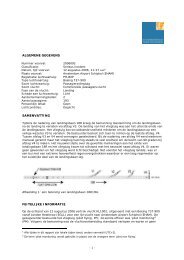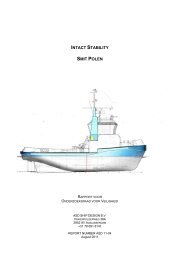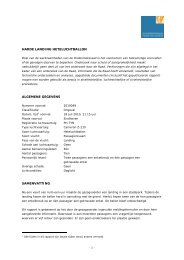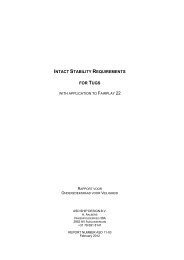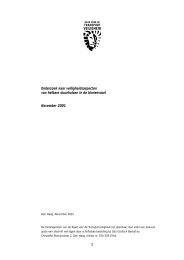Rejected takeoff after the takeoff decision speed 'V ', Boeing B737 ...
Rejected takeoff after the takeoff decision speed 'V ', Boeing B737 ...
Rejected takeoff after the takeoff decision speed 'V ', Boeing B737 ...
You also want an ePaper? Increase the reach of your titles
YUMPU automatically turns print PDFs into web optimized ePapers that Google loves.
To operate a certain route, <strong>the</strong> operator has collected pertinent information for <strong>the</strong> flight crew<br />
to operate a certain route in <strong>the</strong> Performance Manual. Performance Manual provides airfield<br />
performance for specific runways in a format which is readily useable by Flight Crew members. The<br />
manual is available in <strong>the</strong> flight Operations office for flight preparation and a copy is carried in <strong>the</strong><br />
aircraft when flying a particular route.<br />
3.3.2 <strong>Rejected</strong> <strong>takeoff</strong><br />
The operational procedure related to <strong>the</strong> rejected <strong>takeoff</strong> is explained in <strong>the</strong> QRH. The first<br />
procedure (appendix E) describes a number of conditions to reject <strong>the</strong> <strong>takeoff</strong> before 80 knots.<br />
This procedure also describes <strong>the</strong> conditions to reject above 80 knots but prior to V 1<br />
.<br />
In ano<strong>the</strong>r part of <strong>the</strong> QRH <strong>the</strong> rejected <strong>takeoff</strong> is also described (appendix F). The first part<br />
describes <strong>the</strong> conditions in case <strong>the</strong> <strong>takeoff</strong> should be rejected before 80 knots. The procedure also<br />
describes <strong>the</strong> conditions in case <strong>the</strong> <strong>takeoff</strong> should be rejected for <strong>speed</strong>s above 80 knots.<br />
The Flight Crew Training Manual states that regardless of which pilot is making <strong>the</strong> <strong>takeoff</strong>, <strong>the</strong><br />
captain should keep one hand on <strong>the</strong> thrust levers until V 1<br />
in order to respond quickly to a rejected<br />
<strong>takeoff</strong> <strong>decision</strong>. After V 1<br />
, <strong>the</strong> captain’s hand should be removed from <strong>the</strong> thrust levers.<br />
The manual does not recommend to reject <strong>the</strong> <strong>takeoff</strong> unless <strong>the</strong> captain judges <strong>the</strong> aircraft<br />
incapable of flight. Even if excess runway remains <strong>after</strong> V 1<br />
, <strong>the</strong>re is no assurance that <strong>the</strong> brakes<br />
have <strong>the</strong> capacity to stop <strong>the</strong> aircraft before <strong>the</strong> end of <strong>the</strong> runway.<br />
3.3.3 Aircraft separation<br />
In Annex 2 – Rules of <strong>the</strong> Air, of <strong>the</strong> International Civil Aviation Organisation provisions relating<br />
to aircraft separation for wake turbulence are given. General guidance, as does <strong>the</strong> operators<br />
operations manual part A, prescribes <strong>the</strong> minimum separation time between aircraft to be 2 to 3<br />
minutes depending on aircraft weight and/or category.<br />
3.4 ASSESSMENT FRAMEWORK FOR SAFETY MANAGEMENT<br />
A safety management system plays a crucial part in controlling and improving safety. This applies<br />
to all organisations, private and public, that are involved directly from a distance in activities where<br />
people are exposed to hazards. In principle, <strong>the</strong> way in which <strong>the</strong> organisation’s responsibility for<br />
safety is defined in more detail can be assessed from different points of view. There is, <strong>the</strong>refore,<br />
no universal preamble that can be used in all situations. The Board has, <strong>the</strong>refore, selected five<br />
safety items to be addressed that provide an idea about which aspects may play a role:<br />
• Insight into risks as <strong>the</strong> basis for <strong>the</strong> safety approach<br />
• Demonstrable and realistic safety approach<br />
• Implementing and enforcing <strong>the</strong> safety approach<br />
• Tightening <strong>the</strong> safety approach<br />
• Management steering, commitment and communication<br />
These items are based on (international) legislation and regulations and a large number of broadly<br />
accepted and implemented standards. The Board recognises that <strong>the</strong> interpretation of <strong>the</strong> way in<br />
which organisations define <strong>the</strong> details of <strong>the</strong>ir own responsibility with regard to safety will depend<br />
on, for example, <strong>the</strong> nature or size of <strong>the</strong> organisation. These aspects may be important within this<br />
context and should, <strong>the</strong>refore, be taken into account in <strong>the</strong> assessment.<br />
15








